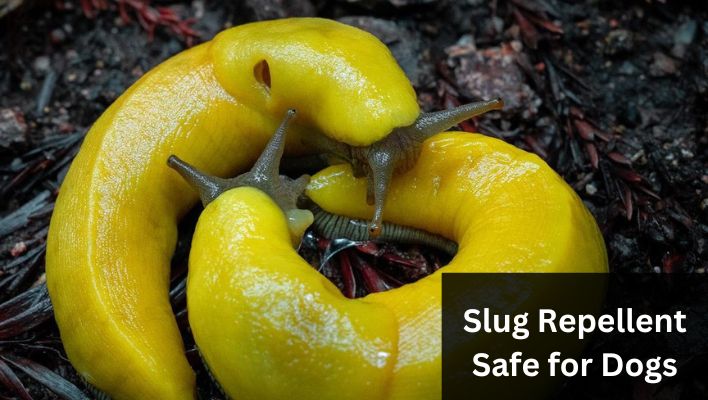We all want to protect our gardens and keep them slug-free, but we shouldn’t have to choose between that and the well-being of our pests. That’s why it’s essential to explore slug-repellent options that won’t harm our pets in the process.
When it comes to slug repellents, it’s crucial to prioritize your dog’s safety. Many traditional options out there might do the trick in warding off slugs, but they could spell trouble for your furry friend.
We’re talking about harmful chemicals and toxic substances that could lead to unwanted health issues. So, if you’re wondering how to deter slugs without causing any harm to your dogs or other pets, you’re in the right place.
We’ll discuss natural alternatives, safe ingredients to look for, and even homemade solutions that won’t break the bank.
Slugs and Why Are They a Concern for Dogs
Let’s start by getting to know our slimy foes: slugs. These fascinating creatures are gastropods, belonging to the same family as snails. They come in various shapes and sizes, with a distinctive slimy body that helps them glide effortlessly across surfaces. While they may seem harmless at first glance, slugs can pose serious risks to our canine companions.
One of the primary concerns when it comes to dogs and slugs is ingestion. Dogs, being curious by nature, may encounter slugs while exploring the garden or during playtime. And let’s face it, our furry friends have a knack for putting things in their mouths that they shouldn’t!
Now, you might be wondering, “What’s the big deal if my dog eats a slug?” Well, here’s the scoop: slugs can carry parasites, such as lungworms, that can infect dogs. Lungworm infestations can lead to a range of health issues, including respiratory problems, coughing, lethargy, and even potentially life-threatening conditions if left untreated.
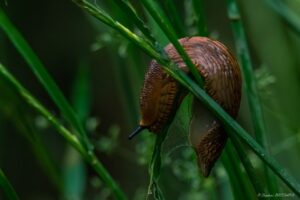
Now, here’s where it gets even trickier – using the wrong slug repellent can be just as dangerous as the slugs themselves. Many common slug repellents available in the market contain chemicals that can be toxic to dogs. These chemicals might effectively repel slugs, but they can also pose a serious threat to our furry friends if they come into contact with them or ingest them accidentally.
That’s why it’s crucial to prioritize the use of safe slug repellents specifically designed for dogs. By opting for dog-friendly slug repellents, you can ensure that your garden stays slug-free while keeping your four-legged companion safe and sound.
The importance of using safe slug repellents cannot be overstated. It’s essential to be cautious and informed about the products we use in our surroundings, especially when it comes to our pets. By choosing repellents that are specifically formulated to be safe for dogs, you can effectively protect your garden from slugs without compromising your furry friend’s well-being.
So, let’s keep our dogs safe from slug-related hazards and explore the world of slug repellents that are both effective in warding off these slimy creatures and completely safe for our canine pals.
The risks associated with traditional slug repellents
When it comes to dealing with slugs, many gardeners turn to traditional slug repellents available in the market. However, it’s essential to be aware of the potential risks associated with these products, especially when it comes to the safety of our furry friends.
Let’s explore the common slug repellents and their adverse effects on dogs and why finding a dog-friendly slug repellent is crucial.
Traditional slug repellents often contain chemicals that can be harmful to dogs if they come into contact with them or ingest them accidentally. Some of these chemicals include metaldehyde, methiocarb, and carbaryl. While these compounds are effective in repelling slugs, they can have toxic effects on our four-legged companions.
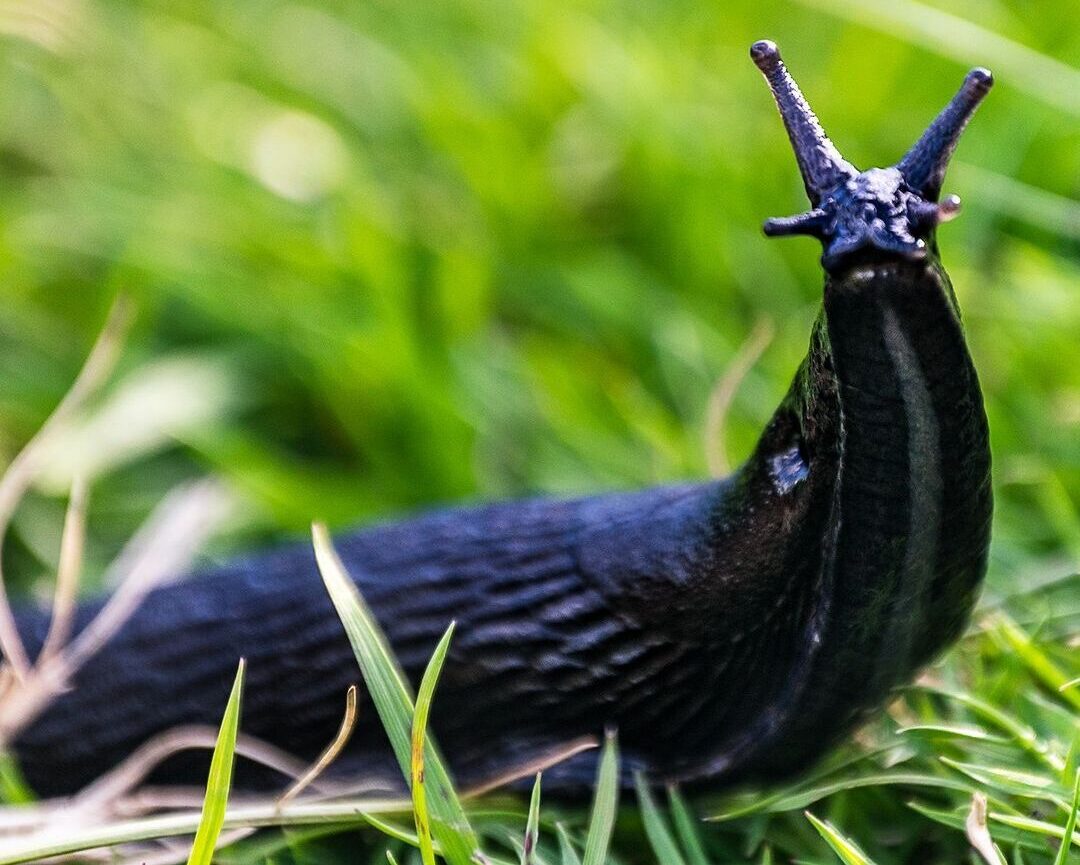
Metaldehyde, a common ingredient in slug pellets, can be extremely toxic to dogs. If a dog ingests these pellets, it can result in symptoms such as tremors, seizures, drooling, increased heart rate, and even respiratory distress.
Methiocarb and carbaryl, found in liquid or granular slug repellents, can also pose risks to dogs. Ingestion of these chemicals can lead to symptoms like vomiting, diarrhea, excessive salivation, and neurological issues.
Considering these potential dangers, it becomes vital to find slug repellents specifically formulated for dogs. Dog-friendly slug repellents are designed to effectively repel slugs while ensuring the safety of our furry companions.
By opting for dog-friendly options, you can provide a slug-free environment for your pup without putting their health at risk.
Now, you might be wondering if there are natural alternatives that can repel slugs safely without harming your dogs and other pets. The answer is a resounding yes! Nature has provided us with a range of effective and safe ingredients that can help keep slugs at bay without posing any threat to our furry friends.
One of the most effective natural ingredients to repel slugs is diatomaceous earth. This fine powder, made from fossilized remains of marine phytoplankton, is harmless to dogs but acts as a barrier that slugs find irritating to cross.
Other natural ingredients to look for in dog-friendly slug repellents include cedar oil, neem oil, and essential oils like peppermint or eucalyptus. These ingredients have repellent properties against slugs while being safe for dogs when used in appropriate concentrations.
Symptoms of Dog Eating Slugs
When a dog eats slugs, it can lead to various symptoms. Here are some common symptoms to watch out for if you suspect your dog has ingested slugs:
- Vomiting: Your dog may vomit as a result of consuming slugs. Look for signs of regurgitation or attempts to vomit.
- Diarrhea: Eating slugs can cause gastrointestinal upset in dogs, leading to loose stools or diarrhea. Monitor your dog’s bowel movements for any changes in consistency.
- Lethargy: Slugs can carry parasites or bacteria that may cause infections in dogs. If your dog becomes unusually tired, lacks energy, or appears lethargic, it could be a sign of an underlying issue.
- Loss of appetite: Ingesting slugs may cause a decreased appetite or a complete loss of interest in food. Keep an eye on your dog’s eating habits and note any significant changes.
- Drooling or excessive salivation: Some slugs release a slimy substance as a defense mechanism. If your dog ingests slugs, it might experience increased salivation or drooling as a result.
- Gastrointestinal discomfort: Dogs may show signs of abdominal pain, discomfort, or bloating after consuming slugs. They may exhibit restlessness or exhibit a hunched posture.
- Behavioral changes: In certain cases, ingestion of slugs can lead to behavioral changes in dogs. This could include unusual agitation, irritability, or restlessness.
If you observe any of these symptoms or suspect that your dog has eaten slugs, it is important to seek veterinary attention promptly. A veterinarian will be able to evaluate your dog’s condition, provide appropriate treatment if necessary, and offer guidance on preventing future slug ingestion to ensure your dog’s well-being.
Dog-Friendly Ways to Get Rid of Slugs
If you’re looking for dog-friendly methods to get rid of slugs in your garden, there are several natural and safe approaches you can take. Here are some dog-friendly ways to control slugs without compromising your furry friend’s well-being:
Handpicking:
One of the simplest and most dog-friendly methods is handpicking slugs. While it might not be the most pleasant task, manually removing slugs and placing them in a bucket of salty water can be an effective way to reduce their population. Just remember to wear gloves and wash your hands afterward to avoid any potential irritation.
Slug barriers:
Creating physical barriers around your plants can help deter slugs. Use materials like copper tape or diatomaceous earth to create a barrier that slugs find difficult to cross. These substances act as a deterrent and can help protect your plants from slug damage. Make sure to follow the application instructions and keep your dog away from the treated areas until the barrier is in place.
Beer traps:
Beer traps are another dog-friendly method to attract and trap slugs. Simply bury a container, such as a shallow dish or jar, in the ground and fill it with beer. Slugs are attracted to the smell of beer and will crawl into the container, where they will drown. Just ensure that your dog cannot access the beer traps, as alcohol consumption can be harmful to them.
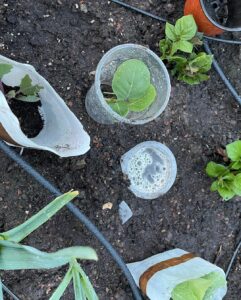
Natural repellents:
Utilizing natural repellents can help keep slugs away from your garden without harming your dog. Ingredients likediatomaceous earth, cedar oil, and essential oils like peppermint or eucalyptus have repellent properties. Sprinkle diatomaceous earth or apply cedar oil or diluted essential oils around the areas where slugs are active. These natural repellents create an inhospitable environment for slugs, encouraging them to seek shelter elsewhere.
Natural predators:
Encouraging natural predators that feed on slugs can help control their population in a dog-friendly way. For instance, attracting birds to your garden by providing bird feeders or bird baths can help keep slugs in check. Additionally, hedgehogs and certain species of frogs are known to eat slugs, so creating a welcoming habitat for them can be beneficial.
Companion planting:
Consider incorporating plants that naturally repel slugs into your garden. Some plants, like lavender, rosemary, and fennel, have properties that repel slugs. By strategically planting these repellent species alongside your vulnerable plants, you can deter slugs without using any harmful substances.
Top Slug Repellents Safe for Dogs
When it comes to protecting our gardens from slugs while ensuring the safety of our furry friends, choosing the right slug repellent is of utmost importance.
One highly effective and dog-friendly option to consider is ferric phosphate slug pellets. below are the top slug repellent safe for dogs
Monterey Sluggo Wildlife and Pet Safe Slug Killer
Looking for a safe slug repellent that won’t harm your furry friends? Look no further than Monterey Sluggo Wildlife and Pet Safe Slug Killer.
This product is specifically designed to effectively control slugs while ensuring the safety of wildlife and pets, including dogs. Let’s take a closer look at its features, ingredients, and usage instructions.

Features:
- Safe for use around pets, including dogs
- Controls slugs and snails effectively
- Provides both repellent and baiting action
- Suitable for use in gardens, flower beds, and potting soil
- OMRI-listed for organic gardening
Ingredients:
Monterey Sluggo contains an active ingredient called iron phosphate, which is safe for dogs and other pets. Iron phosphate works by disrupting the slugs’ feeding behavior, leading to their eventual demise. This natural ingredient is non-toxic and biodegradable, making it an excellent choice for pet owners who prioritize their furry friend’s safety.
Usage Instructions:
- Identify the areas where slugs are active in your garden.
- Sprinkle Monterey LG6555 Sluggo granules evenly around these areas, following the recommended application rates on the package.
- Reapply the repellent as needed, especially after rainfall or heavy watering.
- Keep your dog away from the treated areas until the granules have dissolved or been watered in.
Remember, always read and follow the product label instructions for optimal results and to ensure the safety of your dog.
Garden Safe Slug & Snail Bait
Another safe option for protecting your garden from slugs while keeping your dog safe is Garden Safe Slug & Snail Bait. This product offers effective slug control without posing a threat to your furry companion. Let’s explore its features, ingredients, and usage instructions.

Features:
- Pet-safe slug and snail control
- A granular formulation for easy application
- Long-lasting protection
- Suitable for use in vegetable gardens, ornamental gardens, and flower beds
Ingredients:
Garden Safe Slug & Snail Bait contains iron phosphate as its active ingredient, which is considered safe for dogs. Iron phosphate disrupts the slugs’ feeding habits, leading to their elimination. This pet-friendly ingredient ensures that your dog can roam freely in the garden without any concerns.
Usage Instructions:
- Identify the areas with slug activity in your garden.
- Sprinkle Garden Safe Slug & Snail Bait evenly around these areas, following the recommended application rates provided on the package.
- Reapply the bait as needed, especially after rainfall or heavy watering.
- Keep your dog away from the treated areas until the granules have dissolved or been watered in.
Corry’s Slug and Snail Killer
Corry’s 100511481 Slug and Snail Killer is a safe slug-repellent option that effectively targets these pesky garden intruders while being harmless to dogs. Let’s delve into its features, ingredients, and usage instructions.

Features:
- Safe for use around pets, including dogs
- Kills slugs and snails effectively
- Pellet formulation for easy application
- Long-lasting protection
Ingredients:
Corry’s 100511481 Slug and Snail Killer contains iron phosphate as its active ingredient. This ingredient is safe for dogs, ensuring their well-being while effectively controlling slugs and snails. Iron phosphate works by inhibiting the slugs’ ability to feed, leading to their elimination.
Usage Instructions:
- Identify areas in your garden where slugs are active.
- Scatter Corry’s Slug and Snail Killer pellets evenly around these areas, following the recommended application rates mentioned on the packaging.
- Reapply the pellets as needed, especially after rainfall or heavy watering.
- Prevent your dog from accessing the treated areas until the pellets have dissolved or been watered in.
Bonide Captain Jack’s Slug Magic Granules
If you’re searching for a safe slug repellent that gets the job done, Bonide Captain Jack’s Slug Magic Granules should be on your radar.
This product effectively tackles slugs while ensuring the safety of your furry friend. Let’s explore its features, ingredients, and usage instructions.
Features:
- Safe for pets, including dogs
- A granular formulation for easy application
- Long-lasting protection
- Suitable for use in gardens, flower beds, and ornamental plants
Ingredients:
Bonide Captain Jack’s Slug Magic Granules contains iron phosphate as its active ingredient, making it safe for dogs. Iron phosphate acts by interrupting the slugs’ feeding habits, leading to their control.
This pet-friendly ingredient ensures that your dog can roam freely in the garden without any worries.
Usage Instructions:
- Identify areas where slugs are active in your garden.
- Sprinkle Bonide Captain Jack’s Slug Magic Granules evenly around these areas, following the recommended application rates provided on the package.
- Reapply the granules as needed, especially after rainfall or heavy watering.
- Ensure that your dog is kept away from the treated areas until the granules have dissolved or been watered in.
Tips for Slug Prevention in Your Dog’s Environment
Slugs can be a nuisance in your dog’s environment, but with some preventive measures, you can minimize their presence and create a slug-proof area for your furry friend’s safety. Here are some practical tips to help keep slugs away from your yard, garden, and living space:
- Maintain a tidy environment: Keeping your yard and garden clean and well-maintained is a good starting point. Remove any debris, such as fallen leaves or logs, as they provide hiding spots for slugs. Regularly mow your lawn and trim overgrown vegetation to eliminate potential slug habitats.
- Create barriers: Creating physical barriers can help deter slugs from entering specific areas. Use materials like crushed eggshells, diatomaceous earth, or copper tape around the perimeter of your garden beds or designated dog areas. Slugs find these substances irritating and are less likely to cross them.
- Use organic mulch: Choose organic mulch options like wood chips or straw instead of mulches that retain moisture, such as bark mulch. Organic mulch helps maintain a drier environment, making it less appealing for slugs. Ensure the mulch is spread evenly and not piled up, as damp areas can attract slugs.
- Opt for raised garden beds: Consider using raised garden beds to create a slug-proof area for your plants. Raised beds make it more challenging for slugs to access your plants, especially if you construct them with materials like treated lumber or metal that slugs find difficult to climb.
- Encourage natural predators: Attracting natural predators of slugs to your yard can help keep their population in check. Birds, such as robins or blackbirds, feed on slugs, so provide birdhouses, birdbaths, or bird feeders to attract them. Additionally, amphibians like frogs and toads also prey on slugs, so creating a welcoming environment for them with a small pond or damp area can be beneficial.
- Remove potential food sources: Slugs are attracted to decaying organic matter, so removing potential food sources can discourage their presence. Promptly clean up fallen fruits, vegetables, or other organic debris in your yard. Regularly empty and clean outdoor pet food bowls to prevent attracting slugs.
- Regular inspections: Regularly inspect your dog’s living space, including their kennel or outdoor play area, for any signs of slug activity. Check corners, crevices, and dark areas where slugs might seek shelter. If you find slugs, manually remove them and dispose of them away from your dog’s living area.
- Consider natural repellents: Certain natural substances, like cedar wood chips or certain essential oils, have repellent properties against slugs. Place cedar wood chips or create a border of essential oils, like peppermint or eucalyptus, around your dog’s living space to deter slugs.
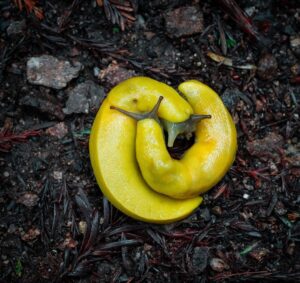 Slug Repellent Safe for Dogs FAQs
Slug Repellent Safe for Dogs FAQs
Can slug slime be harmful to dogs?
Slug slime itself is not typically considered harmful to dogs. However, if a dog ingests a large amount of slug slime or comes into contact with slugs that have been exposed to toxins or chemicals, it could potentially cause gastrointestinal upset or other adverse effects. It’s always best to prevent dogs from ingesting slugs or their slime to avoid any potential issues.
Are all-natural slug repellents safe for dogs?
Not all natural slug repellents are automatically safe for dogs. While many natural slug repellents use pet-safe ingredients like iron phosphate, it’s essential to carefully read the product labels and choose those specifically labeled as safe for pets, including dogs.
Always follow the instructions provided by the manufacturer and consult with your veterinarian if you have any concerns or questions.
How often should I apply slug repellent around my dog?
The frequency of applying slug repellent around your dog will depend on the specific product you’re using and the manufacturer’s recommendations.
Some slug repellents protect for a certain duration, while others may require more frequent application, especially after rainfall or heavy watering. It’s best to refer to the product label or consult with the manufacturer for specific guidelines on application frequency.
Can I use slug repellent on my dog directly?
No, slug repellents are not meant to be used directly on dogs. Slug repellents are formulated for use in outdoor areas, such as gardens or yards, to deter slugs.
Applying slug repellent directly on your dog’s fur or skin can potentially cause irritation or adverse reactions. It’s important to follow the product’s intended use and avoid using it directly on your dog.
Conclusion
It’s important to prioritize the safety of your beloved dog when it comes to dealing with slugs. We have explored the risks associated with traditional slug repellents and highlighted the importance of finding dog-friendly alternatives. By using safe slug repellents, you can effectively repel slugs without putting your dog at risk.
We discussed top slug repellent products such as “Monterey LG6555 Sluggo Wildlife and Pet Safe Slug Killer,” “Garden Safe Slug & Snail Bait,” “Corry’s 100511481 Slug and Snail Killer,” and “Bonide Captain Jack’s Slug Magic Granules.” These products were specifically chosen for their safety and effectiveness in repelling slugs while keeping your furry friend protected.
We also explored dog-friendly ways to get rid of slugs, including handpicking, creating barriers, using beer traps, encouraging natural predators, and companion planting. These methods allow you to control slug populations without compromising your dog’s well-being.
Furthermore, we provided tips for preventing slugs in your dog’s environment, such as maintaining a tidy space, creating slug-proof areas, and removing potential food sources. These measures help create a safe and slug-free environment for your furry companion.
Lastly, we discussed guidelines for using slug repellents safely around dogs, including reading instructions, choosing pet-safe repellents, minimizing contact with treated areas, and monitoring your dog’s behavior. These precautions ensure that your dog remains safe while effectively dealing with slugs.
Remember, the health and safety of your dog should always be a priority. Using safe slug repellents and implementing preventive measures can help protect your dog from the risks associated with slugs and harmful chemicals.
